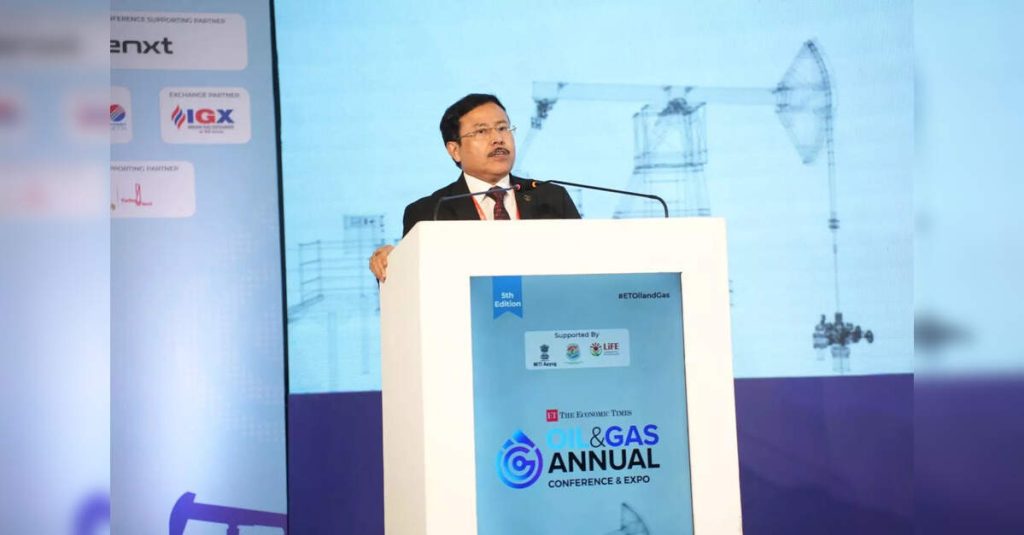
India’s energy future will comprise multiple components coexisting rather than a simple shift from one source to another, Rajarshi Gupta, Managing Director and CEO of ONGC Videsh said in his keynote address at the 5th edition of The Economic Times Oil & Gas Annual Conference & Expo, being held from November 26–28 at Yashobhoomi, New Delhi.
Opening his keynote on Day 2, Gupta described how ONGC Videsh operates across 19 countries with assets in 16, producing more than 100,000 barrels per day from jointly operated projects. With a total output of 10.5 million tonnes annually, it is India’s second largest upstream producer after ONGC.
Gupta said that India’s refining capacity is projected to cross 300 mmtpa by 2030, while gas demand is expected to reach nearly 300 mmscmd. Renewable capacity is also scaling rapidly toward a 500 GW target. These indicators, he noted, show that India’s energy future will comprise “multiple components coexisting” rather than a simple shift from one source to another.
A key part of his address focused on the distinction between energy transition and energy addition. He cautioned against assuming oil and gas would decline in absolute terms, stating that although their share might reduce, the actual quantum required will continue to rise over the next three to four decades.
With crude imports at 85–87 per cent and gas imports at close to 50 per cent, ensuring uninterrupted access to affordable energy remains a national priority.
“With capital costs rising and schedules tightening, project success now hinges on early risk mitigation — from reusing licensed design packages to standardising equipment specifications,” he added.
Gupta also pointed to structural shifts in global energy trade. India now imports crude from around 40 destinations, and third party assessments indicate that nearly 25 per cent of incremental global energy demand will come from India alone. This demand, he said, will influence production patterns, supply chains and commodity pricing across the world.
“A collaborative execution model is essential for large projects. When owners, engineers, suppliers and contractors align on information flow and timelines, engineering decisions and equipment deliveries become significantly faster,” he said.
He highlighted strong future growth in petrochemicals, critical minerals and compressed biogas, supported by recent government policies such as the National Critical Minerals Mission and Cabinet approvals for permanent magnet manufacturing.
A significant portion of his address highlighted the transformation underway in India’s gas economy. Gupta listed five developments that are reshaping the sector: Expanded regasification capacity, accelerated pipeline connectivity, near complete coverage of city-gas distribution networks, liberalised pricing for new gas discoveries, and the launch of India’s gas exchange to enable transparent price discovery.
These interventions, he said, will eventually lead to diversified retail energy outlets where consumers choose between diesel, petrol, CNG, EV charging and green fuels based on price, carbon footprint and availability.
Gupta also discussed India’s growing focus on deepwater exploration. Under the Sagar Manthan initiative, extensive exploration is planned in the Andaman Basin and eastern offshore regions. With only eight of India’s 26 sedimentary basins currently producing, he said deepwater discoveries could become a significant game changer.
On the global front, he noted that international equity oil and gas will remain essential, given that most reserves lie outside India. ONGC Videsh today operates in markets such as Colombia, Brazil, South Sudan and Mozambique, and Gupta said future partnerships will increasingly extend across the upstream, midstream and downstream value chains to create “energy corridors” between complementary nations.
He emphasised the growing need for collaboration in a more volatile, interconnected and technology driven energy landscape. Shared R&D, combined expertise and cross border cooperation, he said, will be essential for developing new fields, advancing CCUS, and accelerating technologies for lower emission production.
Gupta added that digitalisation, AI and automation are already reshaping operations. Automated rigs, AI copilots and real time data systems are enabling new talent pools, especially women, to enter previously inaccessible technical roles. He noted that experience based hierarchies will gradually give way to data driven decision making as younger professionals gain access to advanced tools.
In discussing India’s long-term outlook, Gupta projected that energy demand will grow from 1,600 TWh today to nearly 4,000 TWh by 2035 and around 7,000 TWh by 2047. Multiple layers of supply gas, renewables, pump storage, microgrids and distributed generation will shape the future energy system.
He, however, cautioned that global oil fields face natural decline rates of 6 to 8 per cent annually, making continuous investment in mature fields, enhanced recovery and new exploration critical. Without sustained upstream investment, he warned, supply may fail to keep pace with rising demand.
Gupta said that ONGC and ONGC Videsh remain committed to investing in exploration, strengthening international portfolios and expanding their renewables business through ONGC Green. He added that petrochemicals represent another major area of future growth.
Closing his keynote, he said that India’s energy evolution will require a balanced approach that supports both traditional hydrocarbons and new energy systems. Digitalised operations, lower emission technologies and integrated value chains will be essential to meeting India’s long term growth needs.
He added that recent regulatory reforms have provided stability and clarity for investors, making India “the place to be” for global energy companies looking to participate in a rapidly expanding market.


